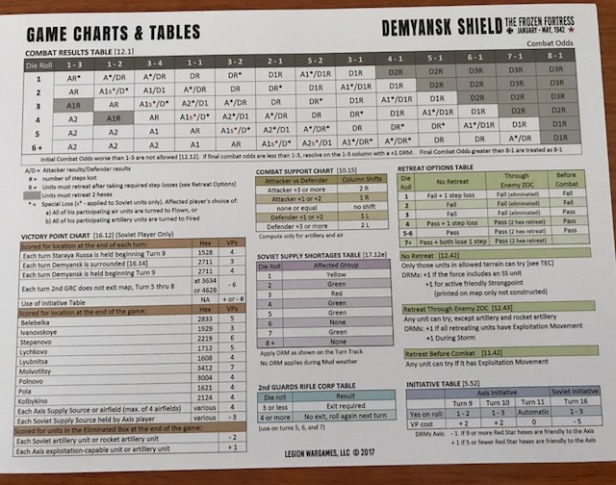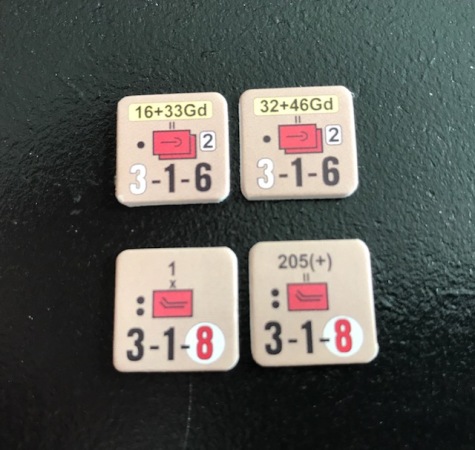Demyansk Shield: The Frozen Fortress is a hex and counter wargame designed by one of the best in the business Vance von Borries that focuses on the fighting between the Germans and Soviets in the Valday Hills area as Army Group North was pushing toward Leningrad. Here, fighting began to settle down in early fall 1941 and by January 1942 had become static. Then the Soviets attacked and by late January, the Soviet 11th Army had broken the German front in several sectors and threatened to surround perhaps 80,000 Germans around Demyansk. When 3rd Shock Army broke the southern wing of the German 16th Army, Soviet advances threatened now to destroy 16th Army and open the flank to Leningrad. It is at this stage that game-play begins.
In this Action Point, I want to take a look at the Combat Results Table used, as well as some of the units that you will encounter in the game, such as Ski Infantry and the Katyusha Rocket Launcher!

CRT
The Combat Results Table or CRT is one of the most interesting and unique that I have seen. It has some odds that are very uncommon but that make for a very interesting game. In the picture above, you can see that the different odds center around the range from 1-1 to 3-1. These odds are the 3-2 and 5-2. I have seen the 3-2 before but I cannot remember once ever seeing the 5-2 odds in a wargame. I would like to ask if there is anyone out there that can think of a game? Anyone?
Well, why is this CRT so unique in my opinion? It has to do with the odds for mainly the Attacker. If you look at the 1-1 column for example, you will notice that there are 5 results, out of a possible 6, that effect the Attacker. These results include A* (Special Loss), A2* (2 Unit step reductions and a Special Loss), A1s* (1 Unit step reduction and a Soviet only Special Loss), AR (Retreat) and A1 (1 Unit step reduction). That means at a 1-1 odds, the Attacker frankly shouldn’t attack. The asterisks are also a pretty interesting part of the game. I will cover this more in my next Action Point, but the asterisk simply means that the player must take a Special Loss, which is defined as affecting all those units of one group that are participating in the combat. Each player has participating air and artillery units that can join in on combat. The air units are represented by such things as Stukas, Heinkels, Ju88’s and Yaks and can be used much more flexibly as they don’t have a range and are not tied to a unit represented in a hex. The artillery units are deployed on the board and have a range value that only allows them to support attacks within that range. These units are used to effectuate a column shift in either direction based upon who has the support superiority in a combat. More often than not, the Germans have the edge in this respect but when that Special Loss result comes up, it takes away their advantage and allows the Soviets to gain the column shift.
In the 3-2 and 5-2 columns, the discrepancy shifts to the Defender. As is expected, as the odds go higher than 3-1, the Attacker has the advantage, which is like most other wargames I have played. I would like to study this CRT more and gain greater insight into its main areas of advantage but after only one play, I just haven’t had the chance to see more of each range of results. Most combat in Demyansk Shield is based on infantry action. Infantry actions take a while to develop and, fortunately, the time scale here allows sufficient time for the battle to come to a resolution. Differential CRTs are appropriate for more tactical time frames. Operational infantry action is pushed along by having the odds in your favor. So, the combination of needed odds and sufficient time allows an odds-based CRT.
Specialized Units
Specialized Units can raise player interest and raise the stakes in proper game-play to get the most out of these units. To this end, the designer Vance von Borries included several Specialized Units from the battle that I think are pretty neat inclusions. After only one play, I have not yet figured out how to best utilize each type of unit but they are definitely interesting and fun to try out. The Specialized Units included in the game are Ski Infantry and Rocket Artillery.

Soviet Ski Infantry
Ski infantry have a larger movement allowance of 8; after all, they can just zip through the snow. They are not overly powered units as compared to most of the other Soviet Infantry units who have a 4-4-6 or 4-3-7, but they serve a purpose nonetheless. They might retreat before defending in combat (unless the weather that turn is Mud or Dry which doesn’t allow this retreat), which is really a neat mechanic that can be used to slow the advance of the Germans on flanks until units can be moved in to reinforce them, and this means they can also screen some sectors and simultaneously threaten an unguarded enemy rear. I found that I would simply play with the Germans, retreating when possible, and then once other units had joined the Ski Infantry, I would put their 3 attack power to use to stage effective counter attacks. They are not great at defending, being assigned only a 1 defense factor, but their mobility makes up for that.

Katyusha Rocket Artillery
The Katyusha multiple rocket launcher is a type of rocket artillery first built and fielded by the Soviet Union in World War II. Multiple rocket launchers such as these deliver explosives to a target area more quickly than conventional artillery, but with lower accuracy and requiring a longer time to reload. They are fragile compared to artillery guns, but are inexpensive, easy to produce, and usable on any chassis.
In Demyansk Shield, the Katyusha units have a line of 3-1-6, so they are tailor made as mobile artillery support. They have a 2 range and can be lined up behind units assaulting German strongpoints to provide their 3 attack factor to the combat.
Rocket artillery automatically turn to their Fired side once it is used and will be unavailable until the next turn. This follows thematically the fact that they were difficult to reload.

We really enjoyed our first play of Demyansk Shield and were really impressed with the varied specialized units, the combat system, including the CRT, and the overall production of the game. Another hit from Legion Wargames and Vance von Borries.
In our next Action Point, we will take a closer look at the combat system and how it works.
If you are interested, you can check out our interview with designer Vance von Borries as well as our unboxing video to get a better feel for the quality components. Once the counters were clipped, they came out very nicely, so don’t play too close attention to the ripped counter in the video. Alexander is a little ham fisted!
-Grant

Well, another awesome article. Thank you!
In reality I have way too many Eastern Front games. However, when so many great games are constantly being designed and released on this fascinating topic I find myself collecting more and more of them. I really like the stuff Legion Wargames puts out and although I don’t have room for it now I would love to play this game in the future.
LikeLike
I don’t recall ever seeing a 5-2 odds.
I always had trouble with 3-2 odds, though. When it was 1-1, 2-1, 3-1 etc, it was really easy. If you didn’t double (or triple, or whatever) the opposing force, you rounded down.
But 3-2 always confused me.
I haven’t used a CRT since I was a kid (Squad Leader was my wargame of choice in college, which didn’t use odds), so maybe it was just me at that time. 🙂
LikeLike